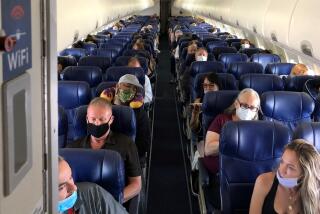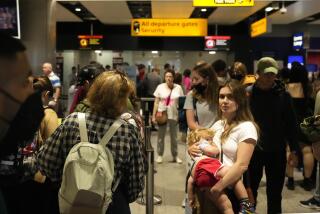When Flying Should Be Avoided
- Share via
While the stresses of flying pose few serious problems for healthy travelers, cruising long distances at 30,000 feet or higher can, in some instances, cause complications for passengers with health problems.
This does not mean that everyone with a chronic illness should think that they can’t fly, said Dr. Terri L. Rock, a Santa Monica physician who specializes in travel medicine.
“I see many people who are always on the go despite the fact that most of them have some sort of medical problem. Some who have had a heart attack assume they are grounded, but that is not so,” she said. “Very few people cannot fly for medical reasons.”
However, specialists in various medical fields have determined that certain medical conditions require special precautions before flying. At the top of the list are people with heart or pulmonary problems. Other groups consist of passengers who recently have undergone surgery or have had medical procedures that allowed air to enter closed body cavities such as the abdomen, and people with sinus or ear infections.
Most problems are the result of reduced oxygen pressure in the cabin when the aircraft flies at high altitudes. According to Dr. Rock, sea-level oxygen pressure can only be maintained in the cabin of an airline flying below about 22,500 feet. Above that, oxygen pressure falls 15% to 18%. Most healthy passengers do not even sense the pressure change, but passengers with compromising physical conditions may be affected.
For example, a drop in oxygen level in the cabin, which results in a corresponding drop in the oxygen level in passengers’ bloodstream, may affect some passengers who have recently had a heart attack, heart surgery or who have chronic obstructive lung disease. For this reason, doctors advise against flying until three to eight weeks after a heart attack or heart surgery and may even discourage some lung patients from flying without extra oxygen.
Other conditions that may prompt a doctor to suggest patients avoid flying are uncontrolled congestive heart failure or arrhythmias (abnormal heart rhythm). Patients with angina (chest pain) that are not being treated or chest pain that occurs when the patient is at rest also should be wary of air travel. Doctors sometimes advise patients that it is safe to fly with angina if they can walk one block or climb one flight of stairs without experiencing chest pain.
While the subject of deaths during flights is not a pleasant one, it does serve to underscore the need for caution. One study published in the Journal of the American Medical Assn. revealed that 577 in-flight deaths were reported between 1977 and 1984 on 42 international airlines, and that more than half of the deaths were related to heart problems. Further, researchers found that 77% of the deaths were among passengers who had no health problems prior to travel and that the majority of them had died of sudden heart attacks.
This finding is being used to bolster a recommendation that cabin crews be trained to do cardiopulmonary resuscitation and to use electric devices that stimulate a stopped heart to start again. Such devices are not currently being used on airlines.
People with pacemakers and implantable cardiac devices should have no problems flying, according to Dr. Jan E. Patterson of Yale University Medical School. And such devices, he wrote in a medical journal article directed at the elderly, are not affected by the metal detectors used by airport security.
Others who are at risk, especially on long flights, are elderly patients prone to developing blood clots. Such clots can travel from leg veins to the lungs. The risk can be reduced, Patterson said, by wearing support hose, walking around the cabin frequently and by doing isometric calf exercises. Patients should obtain bulkhead seats, which offer additional legroom, and avoid inside or middle seats and smoking sections. They should also drink nonalcoholic beverages frequently in order to avoid dehydration.
The ears and sinuses are especially susceptible to pressure changes if they are infected or if the passenger has a bad cold. The infection causes blockages, which prevent the air pressure inside the ear or sinus from equalizing with the pressure in the cabin as the plane descends. Excruciating pain can result. Infants and children are especially vulnerable.
Pinching the nose while forcibly exhaling through the blocked nasal passage can relieve the pain. Swallowing repeatedly, drinking water or chewing gum can help, too. And some doctors advise taking a decongestant before flying.
In a talk to physicians last year in San Diego, Dr. Gary M. Kohn, medical director of United Airlines, said that anyone who has recently had abdominal surgery is apt to be very uncomfortable on an air flight. While not life threatening, the 25% to 30% increase in intestinal gas volume due to decreased cabin pressure could weaken sutured places or cause a problem with trapped air in a body cavity, he said.
Patients who have a colostomy may experience added gas expansion during the aircraft’s ascent and should wear a large bag during flight.
More to Read
Sign up for The Wild
We’ll help you find the best places to hike, bike and run, as well as the perfect silent spots for meditation and yoga.
You may occasionally receive promotional content from the Los Angeles Times.






